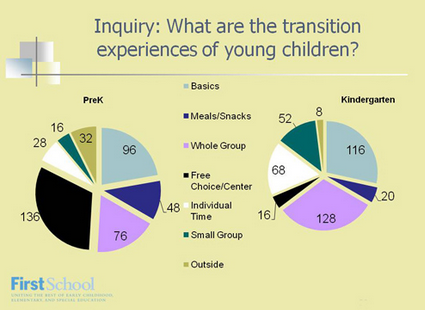Solving Poor Learning Outcomes in Basic Education
Problems in basic education such as children not learning to read can be traced to the early years, the times at which these skills are taught. The same holds true for arithmetic or basic math skills. The third and fourth grades of basic education are pivotal. For this reason, exams and assessments are frequently made at this stage. Poor performance in these tests indicates problems in early education. These can not be addressed by adding two years at the end of high school. These need to be addressed at the primary level where the problems begin to arise. Poor performance in Grade IV as demonstrated below:
Looking at the above figure reveals several differences between daycare (pre-K) and Kindergarten. Kindergarten is usually a bit shorter than full-day childcare. Inside this reduction in hours, there are also dramatic differences in how these minutes are distributed among various activities. Pre-K is less structured while Kindergarten is very much structured by seeing the reduction of free choice time from 136 minutes in pre-K to only 16 minutes in Kindergarten. The examination above essentially looks at the transition in terms of allotted times between daycare and Kindergarten. It is worthwhile to examine how kindergarten and first grade in the Philippines differ in this respect. The above is just an example of some of the questions one may raise in the hope of getting to know early childhood education better, how it ticks, how it works. Research and evaluation is only one of the ten critical features that FirstSchool has identified as necessary for improving pre-K to 3:
Ten Critical Features
Among 25 countries that joined the study among fourth-grade students, we (Philippines) ranked 23rd in both Math and Science, again with scores more than 200 points lower than the first-ranked Singapore!
clearly demands solutions at the primary level of education. It is in fact quite tempting to focus on the early years of education. There is a growing awareness among education reformers that most of the problems basic education currently faces in so many countries can be addressed at the early years. The United States is not an exception. The early years, pre- kindergarten to third grade, are now being examined in great depth and detail. For instance, the Frank Porter Graham Child Development Institute (FPGCDI) at the University of North Carolina, Chapel Hill, enumerates the following reasons why pre-K to 3 is particularly important:
- Children's experiences during the early years provide the foundation for later school success.
- Public school involvement with young children is increasing.
- A variety of federal, state, and local agencies are responsible for the education and care of 3- and 4-year-olds.
- A smooth, coordinated learning experience from ages 3 to 8 is important to children and families.
- America is becoming more diverse.
- From age 3 to 8, children learn the essential foundations of reading and writing.
 |
| Downloaded from http://firstschool.fpg.unc.edu/research-and-evaluation |
Ten Critical Features
- Culturally responsive, engaging and developmentally appropriate curriculum, instruction, and assessment
- Leadership that promotes and sustains change
- Teacher preparation and professional development
- Foundational processes
- Seamless education
- Financing PreK-3
- Home-school partnerships
- Research and evaluation
- Coordinated school health and wellness
- Environments that support learning and communication
 |
| Downloaded from http://firstschool.fpg.unc.edu/presentations |
FirstSchool only started a few years ago, but the program has already yielded some findings as well as developed new ideas. One example is a design guide for schools:
 |
| To read the guide, please click http://firstschool.fpg.unc.edu/sites/firstschool.fpg.unc.edu/files/design_guide_complete.pdf The purpose of the FirstSchool Design Guide is to help communities develop optimal indoor and outdoor learning environments for children ages 3 to 8. The guide offers the rationale for the FirstSchool approach, the evidence base for our principles, examples of how those principles can be expressed and supported in the physical environment, technical considerations and design specifications. The design guide can be downloaded and printed either as a single high-quality PDF or by individual chapter. |
Early Childhood Learning is very important. This phase of basic education should never be taken for granted. The early grades are crucial and failure in these early years has a strong influence on later years of education. The pictures are inviting - these are pictures of children, smiling with much of their future in our hands. Some of the ideas may look ideal and may lie outside our reach. This is quite similar to health care. Paying attention to the early years is akin to staying healthy and preventative care. In the long run, these may actually be less costly than curing a disease, especially when the disease is prevalent. And if we consider each child as our own, there is really no reason not to aspire for something better.
The importance of early childhood education is widely accepted in the United States. Current debate, as described in a recent HuffingtonPost article centers on an equity issue:
The importance of early childhood education is widely accepted in the United States. Current debate, as described in a recent HuffingtonPost article centers on an equity issue:
"Head Start is for the poorest of the poor … so if you say, 'Let's stretch the program so that it's helping the middle class with pre-K access,' you risk not being able to reach all those children in poverty." ...Early childhood education attainment -- and Head Start in particular -- has also been tied to better life outcomes. In 2012, several police chiefs highlighted the need for more and better preschool as a long-term crime reduction tool. James Heckman, a Nobel prize-winning economist, has shown that every dollar spent on Head Start yields $7 to $9 as the program's graduates begin contributing to the economy.
Comments
Post a Comment